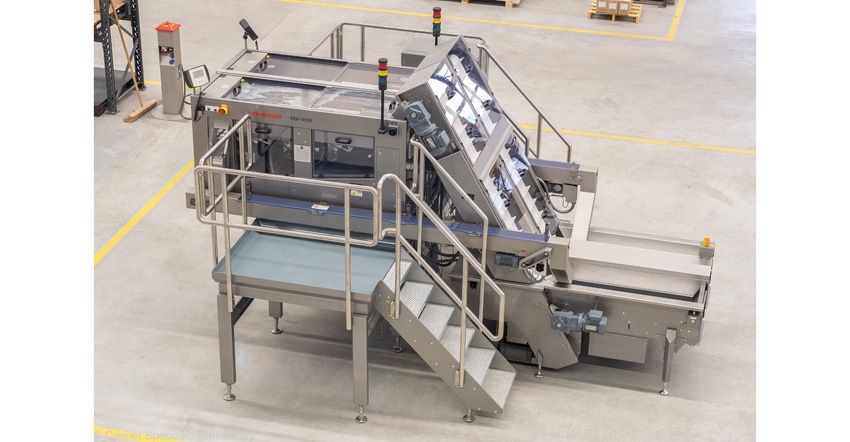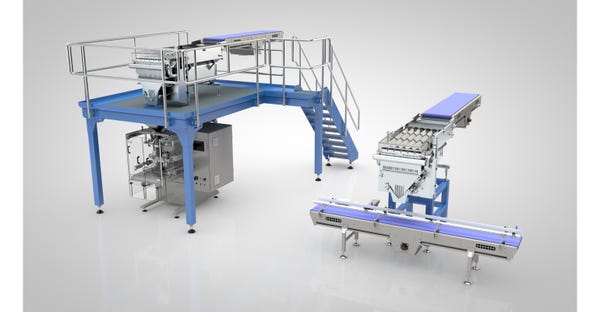Three Ways Counting Pays
Reasons to consider replacing weighing systems with precision optical counting machines
April 22, 2022

René Stuijt, business manager, industrial, Cremer Speciaalmachines B.V.
In packing consumer products, accuracy, quality assurance and customer satisfaction are of utmost importance. When handled correctly, product is apportioned precisely and packaged properly, averting the chance of costly and reputation-damaging errors.
However, a common practice in high-volume manufacturing and packaging operations is packing by weight. For companies utilizing this longstanding technique, they may unfortunately also be weighing down their profit margins and brand reputations.
An increasingly appealing alternative, precision optical counting, guarantees 100% accuracy – an exacting portion control that lends itself to satisfied consumers and an upward trending ROI through significantly decreased product wastage. Counting makes improving profit margins, point-of-purchase marketing, and variety pack apportionment as easy as one, two, three.
Keeping Count of Profits
For companies selling mass quantities of product, quick and precise sorting, quantity apportionment and packing procedures are crucial for manufacturing efficiency and quality control. From an end-of-line standpoint, one of the key decisions a company must make is choosing whether to pack a product according to weight or by product count. This decision--dependent on which will be most accurate for the product at hand--can drastically affect customer satisfaction and bottom-line revenue.
While some production lines utilize weighers to pack pieces by individual weight, there are common issues that can surface using this method. Most frequently, inaccurate quantities can result from product not being the exact same weight. Even products with very minor weight discrepancies can add up to overages, and in turn, result in unnecessary product waste.
The ensuing miscalculation causes a troublesome profitability issue, depending on the type of miscount. Undercounting shortchanges the customer leading to dissatisfaction, negatively affecting a company’s reputation and decreasing sales by tarnishing brand loyalty. Overcounting gives product away for free. The first impacts sales, the latter sell-ability, since you simply can’t sell what you’re handing out as a freebie.
For products with even slightly varying weights, then, packaging apportionment on a per-piece basis is often the most efficient, cost-effective method, as it is significantly more precise than conventional weighing systems in these circumstances. Optical counting--as opposed to weight-centric quality control--guarantees that the net contents in terms of count is 100% accurate for both wholesale and retail packages, preventing product loss and avoiding wastage via over-filling.

Let’s examine some real-world examples. An anonymous customer is running powder dishwashing pacs on a pouch filler with an average speed of 1,800 pacs per minute, or 108,000 per hour. That’s 1,296,000 pacs per 12-hour shift – amounting to 25,920,000 per month.
Now consider this: Before incorporating a precision optical counting system, that customer had an estimated overfill rate approaching 5%. Meaning for every 20 it was packaging and selling, it was giving one away. Unless the company was running a “Buy 20, Get 1 Free” promo, this is a far from satisfactory outcome.
The math is simple – and shocking. At an estimated overfill rate of 5%, that equals more than a million (1,296,000, to be exact) overfilled pouches per month. With a cost per pouch of five cents, product loss comes to an astounding $64,800 per month – and that’s if the manufacturing facility is only running one 12-hour shift. That cost doubles to $129,600 under 24/7 production conditions, which are increasingly common in food and consumer goods sectors.
Now, let’s take a different example: gummy vitamins. While vitamin packaging distinctly states the number of vitamins included in the bottle, if a manufacturer is apportioning its product by weight, a consumer will commonly either get an under or overcount. This means that 90 count of a kid’s multi-vitamins a customer just purchased could in all likelihood have as little as 88 or as many as 92 gummies.
An overcount? The customer makes out with a few extra at the manufacturers’ expense. An undercount? That customer will be off to a bad start one morning when realizing there is a shortage in daily vitamin dose for one of their children.
Compare that to a counting machine, which is guaranteed to be 100% accurate. Here, calculating monthly product losses becomes much simpler and much more acceptable: zero products wasted, zero dollars lost.
As for undercounts, the advantage counting brings is clear: No more complaints from customers who purchased a 20-count package with 19 items. Since each official complaint represents exponentially more disappointed customers, the salvaged brand reputation and customer loyalty translates directly to bolstered profitability.
Providing Point-of-Purchase Clarity
Counting products not only contributes to significant ROI by eliminating wasted product and protecting post-purchase brand reputation, it also helps customers visualize exactly what the package contains before making a purchasing decision. This information can be a differentiator at the point of purchase.
With many products it is easier for consumers to grasp “how many” rather than “how much.” For example, let’s say someone is planning a get-together, and at the frozen foods section to pick out a party staple: meatballs. They know approximately how many guests will attend the gathering and have a decent idea of how many meatballs the average guest will eat. Our party planner sees three brands to choose from. Two of the bags are labeled “6 lbs,” the other “140 pieces.”
Now, unless our party planner knows how much the average frozen meatball weighs, which of these packages gives our shopper the best idea of how many meatballs to buy? The point is that, in this scenario and similar ones, the consumer thought process plays out in numbers – not weight. Insight on the combined weight of the package’s contents is much less beneficial than knowing the exact product count in the package. This is especially relevant when a package is on the larger side – the bigger the package, the more nebulous total weight becomes.
Furthermore, product counts give customers more useful information on how frequently to purchase said product, providing easier-to-track insight as to when they may be running low. For example, it would be significantly more useful to know how many laundry tablets come in a package rather than their total combined weight. This allows consumers to better calculate the duration it will take to empty the package and when they’ll need to repurchase that item.
Guaranteeing Precise Variety Pack Apportionment
Counting systems also offer clear benefits for manufacturers of food product assortments, who are looking to gain increased inventory control and ensure precision in their variety packs.
For example, apportioning and packaging wrapped food assortments like mixed chocolates, candies, and coffee pods can be an intricate process. However, customizable counting systems can guarantee mix composition in variety packs is 100% accurate and consistent for necessary quality control – a guarantee simply not made possible by weighers.
For a manufacturer’s mix or variety line, a dedicated counter would be used for each flavor/type. The appropriate count for each is then dispensed into a bucket conveyor under the counter. When the preset quantity of each flavor is reached, the bucket conveyor dispenses the total amount of product into an integrated packaging machine – typically a cartoner and/or bagger. The counter system is fully customizable per assorted product ranges, For example, four flavors would utilize four counters, and likewise for six, eight, or more.
Additionally, depending on required line speed, more than one counter can be dedicated per flavor/type. For example, if a chocolate assortment requires more dark chocolate than other flavors, the system would dedicate two counters to dark chocolate, one for milk chocolate, and one for caramel.
René Stuijt is business manager, industrial for Cremer Speciaalmachines B.V., a global supplier of counting machines and packaging solutions for the pharmaceutical, food, consumer goods, and agricultural industries. For more information, visit www.cremer.com.
You May Also Like


